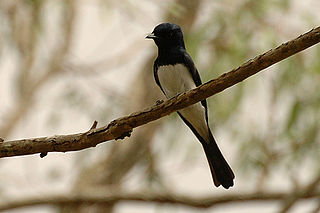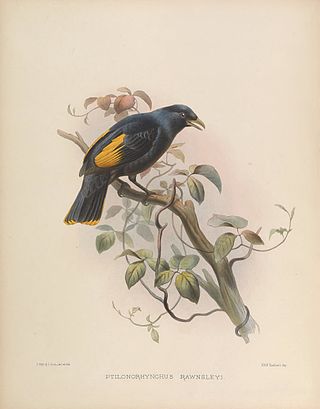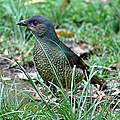
Bowerbirds make up the bird family Ptilonorhynchidae. They are renowned for their unique courtship behaviour, where males build a structure and decorate it with sticks and brightly coloured objects in an attempt to attract a mate.

The great bowerbird is a common and conspicuous resident of northern Australia, from the area around Broome across the Top End to Cape York Peninsula and as far south as Mount Isa. Favoured habitat is a broad range of forest and woodland, and the margins of vine forests, monsoon forest, and mangrove swamps.

The crimson rosella is a parrot native to eastern and south eastern Australia which has been introduced to New Zealand and Norfolk Island. It is commonly found in, but not restricted to, mountain forests and gardens. The species as it now stands has subsumed two former separate species, the yellow rosella and the Adelaide rosella. Molecular studies show one of the three red-coloured races, P. e. nigrescens, is genetically more distinct.

The blue-billed duck is a small Australian stiff-tailed duck, with both the male and female growing to a length of 40 cm (16 in). The male has a slate-blue bill which changes to bright-blue during the breeding season, hence the duck's common name. The male has deep chestnut plumage during breeding season, reverting to a dark grey. The female retains black plumage with brown tips all year round. The duck is endemic to Australia's temperate regions, inhabiting natural inland wetlands and also artificial wetlands, such as sewage ponds, in large numbers. It can be difficult to observe due to its cryptic nature during its breeding season through autumn and winter. The male duck exhibits a complex mating ritual. The blue-billed duck is omnivorous, with a preference for small aquatic invertebrates. BirdLife International has classified this species as Least concern. Major threats include drainage of deep permanent wetlands, or their degradation as a result of introduced fish, peripheral cattle grazing, salinization, and lowering of ground water.

The green catbird is a species of bowerbird found in subtropical forests along the east coast of Australia, from southeastern Queensland to southern New South Wales. It is named after its distinctive call which sounds like a cat meowing, although it has also been mistaken for a crying child. The green catbird resembles the spotted catbird, which is found in wet tropical rainforests of Far North Queensland.

The Vogelkop bowerbird, also known as the Vogelkop gardener bowerbird, is a medium-sized bowerbird of the mountains of West Papua.

The greater lophorina, also known as superb bird-of-paradise or greater superb bird-of-paradise, is a species of the Paradisaeidae (bird-of-paradise) family. It was considered the sole species in the genus until in 2017 it was recognised that there were three species.

The golden bowerbird is a species of bird in the family Ptilonorhynchidae, the bowerbirds. It is endemic to Queensland in Australia, where it is limited to the Atherton region.

The spotted catbird is a species of bowerbird (Ptilonorhynchidae) which can be found in north Queensland, the eastern Moluccas and New Guinea. Although it is a member of the bowerbird family it does not build a bower.

The regent bowerbird is a medium-sized, up to 25 cm long, sexually dimorphic bowerbird. The male bird is black with a golden orange-yellow crown, mantle and black-tipped wing feathers. It has yellow bill, black feet and yellow iris. The female is a brown bird with whitish or fawn markings, grey bill, black feet and crown. The name commemorates a prince regent of the United Kingdom.

MacGregor's bowerbird is a medium-sized, up to 26 cm long, olive brown bowerbird of New Guinea's mountain forests, roughly the size and shape of an American Robin or a Eurasian Blackbird. The male is adorned with an erectile orange yellow crest, that is partly hidden until shown in courtship display. The unadorned female is similar to the male, but without the crest. Superb mimics, they are known for imitating other birds, pigs, rushing water, and even human speech.

The genus Ptiloris consists of four allopatric species of birds in the family Paradisaeidae. These birds of paradise are commonly known as riflebirds, so named for the likeness of their black velvety plumage to the uniform of the Rifle Brigade. Alternatively, the bird's cry is similar to a rifle being fired and hitting its target but a call like this is not commonly reported. They are distributed in the rainforests of New Guinea and Eastern Australia.

Mate choice is one of the primary mechanisms under which evolution can occur. It is characterized by a "selective response by animals to particular stimuli" which can be observed as behavior. In other words, before an animal engages with a potential mate, they first evaluate various aspects of that mate which are indicative of quality—such as the resources or phenotypes they have—and evaluate whether or not those particular trait(s) are somehow beneficial to them. The evaluation will then incur a response of some sort.

The spotted bowerbird is a sedentary, mid-sized passerine found across broad parts of the drier habitats of eastern Australia. The species is known for its remarkable behaviours, like many other bowerbirds (Ptilonorynchidae), which include bower building and decorating, courtship displays and vocal mimicry. Spotted bowerbirds are locally common, however, overall the population is thought to be in decline.

The western bowerbird is a species of bird in the family Ptilonorhynchidae. The species is a common endemic of Australia. It has a disjunct distribution, occurring in Central Australia and the Pilbara region of Western Australia.

The satin flycatcher is a species of bird in the family Monarchidae. Males stand out with their blue-black feathers contrasting their white bellies, and the females with their bright orange throats. It breeds mostly in south-eastern Tasmania and Australia. It is declining throughout the eastern seaboard due to predation from the introduced Red Fox and habitat loss. It is a vagrant to New Zealand.

A courtship display is a set of display behaviors in which an animal, usually a male, attempts to attract a mate; the mate exercises choice, so sexual selection acts on the display. These behaviors often include ritualized movement ("dances"), vocalizations, mechanical sound production, or displays of beauty, strength, or agonistic ability.

Rawnsley's bowerbird, also known as Rawnsley's satin bird or the blue regent, is a rare intergeneric hybrid between a satin bowerbird and a regent bowerbird.

Structures built by non-human animals, often called animal architecture, are common in many species. Examples of animal structures include termite mounds, ant hills, wasp and beehives, burrow complexes, beaver dams, elaborate nests of birds, and webs of spiders.

Sexual selection in birds concerns how birds have evolved a variety of mating behaviors, with the peacock tail being perhaps the most famous example of sexual selection and the Fisherian runaway. Commonly occurring sexual dimorphisms such as size and color differences are energetically costly attributes that signal competitive breeding situations. Many types of avian sexual selection have been identified; intersexual selection, also known as female choice; and intrasexual competition, where individuals of the more abundant sex compete with each other for the privilege to mate. Sexually selected traits often evolve to become more pronounced in competitive breeding situations until the trait begins to limit the individual's fitness. Conflicts between an individual fitness and signaling adaptations ensure that sexually selected ornaments such as plumage coloration and courtship behavior are "honest" traits. Signals must be costly to ensure that only good-quality individuals can present these exaggerated sexual ornaments and behaviors.

































